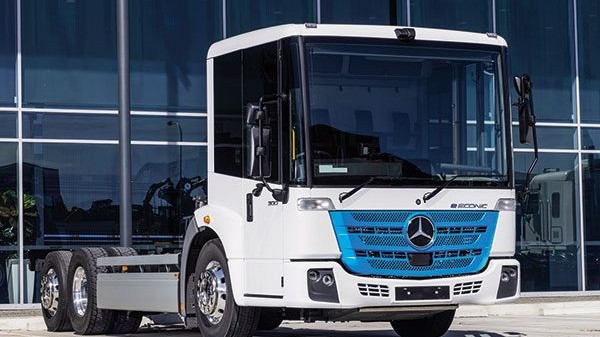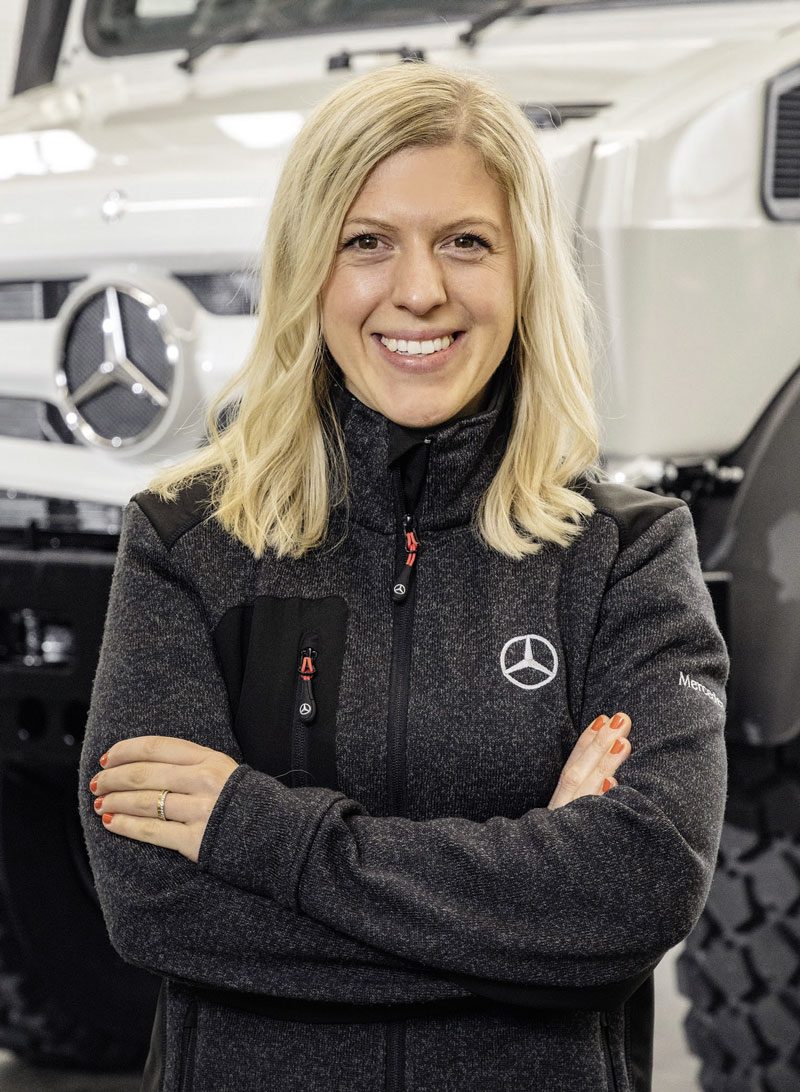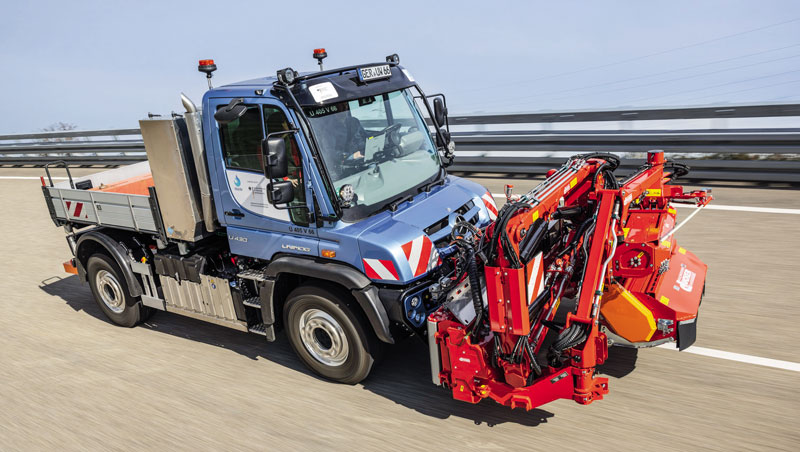When it’s anything but normal

Having the Mercedes-Benz eEconic a feature of the Daimler Truck stand at the Brisbane Truck Show this year, it’s not surprising Special Trucks divisional head, Franziska Cusumano was in town. Although there to celebrate all of the charges in her keep, there’s no doubt eEconic’s impending arrival on the Australasian scene is a significant opportunity for the company through the next phase of regional decarbonisation.
‘Anything but normal’ is a headline easily able to sum up the general mood in global road transport. Yet, anything but normal is the only constant for the 1000 folk who work in the Mercedes-Benz Special Trucks division. With three products – Unimog, Zetros, and Econic, this fascinating part of the Daimler Truck empire is sited at two locations – the main plant in Wörth, Germany, and the customer-specific conversion and adaptation facility in Molsheim, France.
The level of adaptation, evolution and customisation in the division is hard to convey, but it’s probably best exemplified by the fact a fifth of the headcount works in pre-development and development testing. Indeed, the division has its own R&D budget. Special Trucks then, are the experts for special applications and tricky customer requests.
“It’s an exciting area to work in,” says the head of Mercedes-Benz Special Trucks, Franziska Cusumano. “Although a lot of our work stems from the not-so-good things that happen; floods, fires, humanitarian aid, and of course, military applications, it’s heartening to know our vehicles are chosen because they can be relied on to get help through.”

Unimog and Zetros are the go-anywhere solutions, and it would be fair to say that Unimog is the better-known member of the duo. For decades, the ‘Moggy’ has enjoyed an almost cult-like status worldwide for capability and an unwillingness to lie down and die. “There’s a standing joke,” laughs Cusumano. “Asking a customer how long their Unimogs last? The answer coming back, ‘I don’t know yet, they’re only 60’.”
Zetros, the bigger, bonneted, unstoppable option, is equally rugged but doesn’t enjoy the same limelight. If the Unimog is too small for the average punter, then often an all-wheel-drive Arocs will likely suffice. That leaves Zetros for the real gnarly, up-sized ‘go where no truck has gone before’ enterprises. We have a wee smattering of them here in New Zealand, set up as spreaders and in boutique applications such as power-pole placement (New Zealand Trucking magazine – July 2020; Zetting the Precedent)
Not at all difficult to find here though is the other member of Special Trucks division, Econic. It’s presence in the division comes about due to the breadth of variance in what customers demand, globally.
This manoeuvrable, low-entry, high-visibility metro truck defines utility. It’s a truck rarely associated with the glamour end of trucking, and more often than not the one we associate with the weekly collection of that for which we have no further use.
Yet, the plethora of concrete jungle assignments able to be picked up by Econic is bounded only by customer imagination; grocery distribution, bulk liquid, controlled temperature, cement mixer and inner-city vehicle recovery instantly spring to mind.
The more our city fathers around the world constrain the operating hours, decibels and dimensions of trucks affecting the last-mile inner-urban task, the more Econic and its brethren will poke their headlights above the parapets of resolution. And Econic’s appeal might be about to go stratospheric. It’s time in the limelight may well be upon us.
Econic is the first of the Special Truck trio to earn its ‘e’ badge, and although real numbers of eEconic won’t arrive in Australia en mass until Q1 2024, its future relevance and importance cannot be underestimated. “Interest in the truck is huge,” says Andrew Assimo, vice president of Mercedes-Benz in Australia and New Zealand.
Logically, the zero-emissions transport journey emanates from the most populous areas – where the low-hanging fruit of decarbonisation are, and exactly where you find Econic.

The managing director of Daimler Truck Australia and New Zealand, Daniel Whitehead, picks up the thread: “Initially, interest in CO 2 neutral trucks came from the marketing department. That’s all changed. Today, sales are born out of operations and sound business – logical decisions based on TCO, not just future emissions obligations.
“eCanter looks like a Fuso Canter, so it’s easily accepted. With its low cab height, expanse of glass and left-side coach-door entry, the Econic range is its own thing. Our job is to show the customer that this is a heavy Mercedes-Benz truck, capable of so much more than simply picking up garbage. This is a multi-purpose machine that meets the most exacting CBD regulations, it has all the modern safety features, and is now locally CO2 neutral.”
While absolute comparative cost numbers were not forthcoming – it’s easy to argue when there’s no ‘normal’ in your division – Assimo confirmed the up-front cost is currently significantly greater. ‘Currently’ is the key word; like we’ve said before, it’s a numbers and regulatory game at the moment. Whether here, Australia, or anywhere around the globe, central and local governments must put their shoulders to the wheel and create an environment whereby users are incentivised, helping the OEMs push on to mass-manufacture ‘utopia’. That said, even now, the lack of R&M and the ability for customers to actively manage their energy costs means you might well expect to be in the black at about five to six years from your eEconic leaving the showroom – depending on the usage, of course.
“There are three key factors,” says Cusumano. “Product, infrastructure and cost parity. All key stakeholders have a role to play in bringing them to where they need to be.”
Understandably the Special Trucks division sources as much componentry from the A-line products as possible, adding the sugar and spice where necessary.
Econic’s base chassis is sourced from Actros and to date the standard eActros battery packs have performed admirably in eEconic. At face value, the eEconic applications might not appear ‘battery friendly’. Take urban rubbish collection, demanding an absurdly large daily stop-start tally, one not even a busy metro delivery truck could get near. Neither are they generally operated with overt empathy in terms of fuel consumption on such tasks – read battery conservation. However, the ability to accurately plan recharging times, route specificity, and constant regeneration events on the job add to the credit side of the wear ledger also. In Arctic testing – cold being another battery nemesis – the trucks proved faultless when tested in parity with real world aggressive, stop/start operation.
“Engineers never smile and never say ‘Yes’ easily,” laughs Cusumano, “so when they do both, you know it’s a great victory.
“I’m not saying we won’t work to improve the battery performance – make them stronger, with improved performance, but for now, we do not need anything special.”
As is the norm for ‘e’ alternatives, the eEconic is manufactured in the existing Mercedes-Benz Special Trucks assembly line, in parallel and flexibly alongside the trucks that will be powered by internal combustion engines. After the vehicle has been largely assembled, the eEconic’s electrification continues in the Future Truck Center, where – just like the eActros – it is equipped with the electric drive components.
That’s eEconic, its capability conveyed well; there’s an exciting story ahead for it in the region. But let’s end with a fantastic Special Trucks epilogue, one that encapsulates the essence of the division, and the Unimog in particular.
When is the propulsion answer for tomorrow’s vehicle not EV or hydrogen-based fuel cell? When it’s a hydrogen combustion Unimog. In Germany currently there is a prototype Unimog implement carrier for municipal services running a Mercedes-Benz hydrogen combustion engine. The reason for this back-to-the-future vehicle is two-fold. Firstly, in Europe, the Unimog is used heavily for all manner of local body works – roadside mowers, snow blowers, things like that. Being a small truck, chassis packaging – or lack of it – is critical if you are to get all of your ancillary bits onboard, not to mention payload capability. On that latter criterion, also consider applications like bushfire tenders and suppressant payload capacity.
Secondly, the emergency services folk were none too keen on the thought of driving their ‘e’ or H2 FCEV ’Moggy’ into a raging bushfire, flooded river, etc. The result? A mid-range hydrogen combustion engine as an option in the Unimog… for now, at least.
“We have had 19 partners working on the project to date,” says Cusumano. “Tertiary institutions, engineering, injection and tank systems specialists have all been involved. The power and torque profile is on par with existing ICE engines, as are the physical size and fuel tank requirements. To date, the truck has performed fantastically well.”
Suffice to say. The future of transport solutions will be a many and varied thing indeed.








